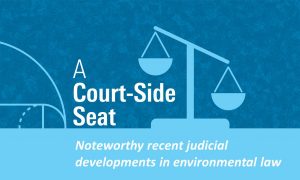The Supreme Court issued 58 opinions in the October 2022 Term. Rulings in several cases will affect the practice of regulatory and administrative law either directly or indirectly, as is recounted below. Before the Court adjourned, it released its calendar of cases to be argued in October 2023, and of course, more cases will be scheduled after the Court returns.
Real Estate & Construction News Roundup (08/15/23) – Manufacturing Soars with CHIPS Act, New Threats to U.S. Infrastructure and AI Innovation for One Company
In our latest roundup, wildfires wreak havoc in Maui, JLL unveils an AI specifically for commercial real estate, the lasting effects of the CHIPS ACT, and more!
Real Estate & Construction News Roundup (08/08/23) – Buy and Sell With AI, Urban Real Estate Demand and Increasing Energy Costs
In our latest roundup, we look at AI’s ability to buy and sell real estate, good news from the Labor Department for federally contracted construction workers, the continued promise of proptech, and more!
Foreign Entry into the United States Construction, Infrastructure and PPP Markets
Two major forces are combining to create extraordinary opportunities for infrastructure project participants in the United States. One is the long pent-up demand for overhaul of the nation’s roads, ports, dams and other civil works. The American Society of Civil Engineers (ASCE) routinely awards “C-” or worse grades for the status and safety of the country’s backbone facilities. The lack of prior investment is apparent to anyone who uses public transit in the U.S. and then uses similar conveniences in major cities around the globe.
Summarizing Changes to NEPA in the Fiscal Responsibility Act (P.L. 118-5)
The National Environmental Policy Act (NEPA) was signed into law on January 1, 1970, and it has rarely been amended or revised since then. NEPA is basically a procedural statute which requires Federal permitting authorities, before a major federal project is approved, to carefully consider the significant environmental consequences of the proposed federal action. NEPA has been employed to conduct a probing review of wide variety of federal projects and actions, and the President’s Council on Environmental Quality (CEQ) has promulgated a comprehensive set of rules and guidance documents that must be followed or consulted. (See 40 CFR Section 1500 et seq.) The first set of NEPA rules was issued in 1978, and very little was done to bring the rules up to date until 2020. The first phase of this review has been completed, and a second and final phase will soon be underway. The NEPA review process includes the use of “categorical exclusions,” environmental assessments and environmental impact statements to measure the environmental impact of a proposed project. Over time, the rules and their implementation and judicial interpretation have become ever more complex, and an enormous body of NEPA case law has resulted.
A Survey of New Texas Environmental and Regulatory Laws Enacted in the 88th Session (Updated)
This is a brief survey of many of the environmental and regulatory laws passed by the Texas Legislature and signed by the Governor in the 88th Regular Session of the Legislature, which ended in May 2023, although a special session has been called to address lingering matters. Altogether, more than 1,000 laws were enacted in this session, including a surprising number of water-related environmental bills.
Real Estate & Construction News Roundup (07/11/23) – The “Ultimate AI Concierge”, Judicial Block on Natural Gas Pipeline and Ecofriendly Construction
In our latest roundup, AI revitalizes a real estate sector, climate change exacts a toll on America’s roads, Las Vegas debuts the world’s largest LED screen, and more!
Real Estate & Construction News Roundup (07/05/23) – A Hospitality Strike in Southern California, Agencies Step in With Lenders and the Social in ESG
In our latest roundup, we see promising developments for climate change action in commercial real estate, how homeowners are reacting to new energy concerns, the fallout of the U.S. debt ceiling fight on global M&A deals, and more!
Real Estate & Construction News Roundup (06/28/23) – Combating Homelessness, U.S. Public Transportation Costs and the Future of Commercial Real Estate
In our latest roundup, we examine the Supreme Court’s ruling regarding water supply responsibilities, the federal reserve chair’s reaction to possible banking losses, several analyses of the future of commercial real estate, and more!
PFAS and the Challenge of Cleaning Up “Forever”
 From a stream of legal challenges, to ever-expanding regulations on things like cosmetics and drinking water, PFAS are the “forever chemicals” keeping companies and consumers on high alert. While industries scramble to remove the synthetic compounds from products, scientists are researching new techniques for scrubbing PFAS from the environment. There is money to be had for those who can find a more streamlined method of purging the substances—the U.S. Army Corps of Engineers has an $800 million contract on the table for the handling, destruction and replacement of PFAS-laden fire-fighting foam—leaving technology companies racing to create solutions. The three main PFAS cleaning techniques currently relied upon can be very effective but are also costly and may leave questionable byproducts in their wake.
From a stream of legal challenges, to ever-expanding regulations on things like cosmetics and drinking water, PFAS are the “forever chemicals” keeping companies and consumers on high alert. While industries scramble to remove the synthetic compounds from products, scientists are researching new techniques for scrubbing PFAS from the environment. There is money to be had for those who can find a more streamlined method of purging the substances—the U.S. Army Corps of Engineers has an $800 million contract on the table for the handling, destruction and replacement of PFAS-laden fire-fighting foam—leaving technology companies racing to create solutions. The three main PFAS cleaning techniques currently relied upon can be very effective but are also costly and may leave questionable byproducts in their wake.





